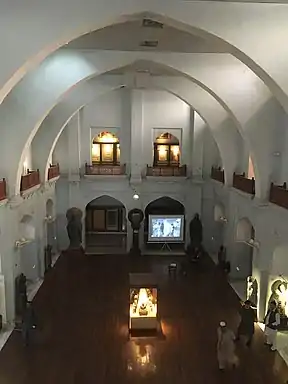Peshawar Museum
The Peshawar Museum (Urdu: پشاور میوزیم(colloquial); پشاور عجائب گھر (official)) is a museum located in Peshawar, capital of Pakistan’s Khyber Pakhtunkhwa province. The Peshawar Museum is notable for its collection of Buddhist artwork dating from the ancient Gandhara Empire.
پشاور عجائب گھر | |
The Peshawar Museum is noted for its collection of ancient Gandharan art Main hall of the Peshawar Museum | |

| |
Former name | Victoria Hall |
|---|---|
| Established | 1907 |
| Location | Peshawar, Khyber Pakhtunkhwa, Pakistan |
| Coordinates | |
| Owner | Government of Khyber Pakhtunkhwa |
| Website | www |
Background
The Peshawar Museum was founded in 1907 as "Victoria Hall," in memory of Queen Victoria. The two-story building was built in a syncretic architectural style consisting of British, Hindu, Buddhist and Mughal Islamic styles.
The museum initially had only one exhibition hall, but two more were added in 1969–70. In 2004–05, the museum was further expanded with the construction of a new block with two galleries, two halls for the museum's collection in storage, offices for the provincial directorate of archaeology, a conservation laboratory and a cafeteria. The historic exhibition hall was also renovated at that time.
Collection
The current collection has almost 14,000 items based on Gandhara, Greco-Buddhist, Kushan, Parthian, and Indo-Scythian life. Examples include art, sculptures, coins, manuscripts, statues, ancient books, early versions of the Quran, weapons, dresses, jewelry, Kalash effigies, inscriptions, paintings of the Mughal and later periods, household materials and pottery, as well as local and Persian handicrafts.
Gandhara and Greco-Buddhist Art

Peshawar Museum has one of the largest and most extensive collections of Gandhara art of the Buddhist period and is considered to be one of the biggest collections of Buddhist objects in the world. The museum also contains the largest collection on Gautama Buddha. Buddhist stone sculptures, terracotta figurines, and other Buddhist objects. The display of Gandhara art in the main hall includes Buddha's life stories, miracles, worship of symbols, relic caskets, and individual standing Buddha sculptures. The ethnological objects of that period are also exhibited in the museum.
Numismatics
.jpg.webp)
The Peshawar Museum has 8,625 coins, 4,510 of which are pre-Islamic. The main interest of the museum's numismatic collection is that the coins were recovered from archaeological sites, including: Shah-Ji-Ki-Dheri, Shari Bahlol, Takht-i-Bahi and Jamal Garhi. The collections of Bactrian Greek, Indo-Greek, Indo-Scythian, Indo-Parthian and Kushan coins have been published.[4]
Mughal and Persian Islamic Art
This gallery exhibits wooden facades of mosques, ancient Arabic and Persian inscriptions, fine Multani tiles and ceramics, and the dresses and weapons of Syed Ahmad Shaheed Barailvi and numerous ancient leaders. Some of the best works are the Mughal Islamic metal artifacts in bronze and silver, the calligraphic specimens and scrolls that date as far back as 1224.
Middle Age and British Rule to Present
This gallery mainly consists of items displaying the culture and life of the major tribes of the Khyber Pakhtunkhwa province, and the Kalasha Desh located in the far north of the province, where a small tribe of animists called the Kalash live. The museum exhibits cultural items of the Kailash Valley. Exhibits also include swords, daggers, spears, long bows, recurve bows, arrows, shields, muzzle-loading guns, revolvers, pistols and gunpowder boxes
.jpg.webp) Standing Buddha
Standing Buddha Seated Bodhisattva
Seated Bodhisattva Sahri Bahlol Buddha, excavated 1909-1910
Sahri Bahlol Buddha, excavated 1909-1910
See also
Notes
- Rhi, Juhyung. Identifying Several Visual Types of Gandharan Buddha Images. Archives of Asian Art 58 (2008). pp. 53–56.
- The Classical Art Research Centre, University of Oxford (2018). Problems of Chronology in Gandhāran Art: Proceedings of the First International Workshop of the Gandhāra Connections Project, University of Oxford, 23rd-24th March, 2017. Archaeopress. p. 45, notes 28, 29.
- Chandrasekhar, Anand. "How you move a priceless 1.5-ton Buddha across continents". SWI swissinfo.ch.
- Frontier Archaeology Issues 1 and 2
References
- Frontier Archaeology Vol.II, 2004, Catalogue of Coins in the Peshawar Museum No.1 Kushan Period (ed. Ali, I), Directorate of Archaeology & Museums
- Frontier Archaeology Vol.IV, 2006, Catalogue of Coins No.2 Indo-Greek and Scytho-Parthian Period (ed. Ali, I), Directorate of Archaeology & Museums
| Wikimedia Commons has media related to Peshawar Museum. |

